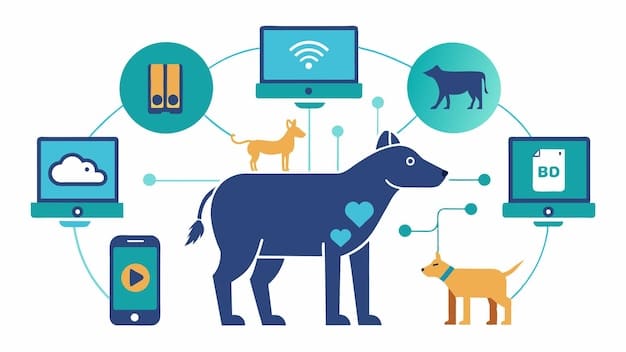Maximizing Adoption Rates: Proven Strategies for US Shelters in 2025

Maximizing adoption rates in US animal shelters by 2025 involves implementing innovative strategies, enhancing community engagement, leveraging digital platforms, and providing comprehensive post-adoption support to ensure successful placements and reduce returns.
Are you passionate about finding forever homes for animals in need? Discover how US animal shelters are maximizing adoption rates in 2025 through innovative strategies and community engagement.
Understanding the Landscape of Animal Shelters in 2025
The animal shelter landscape in the US is constantly evolving, with advancements in technology and shifts in societal attitudes influencing how shelters operate. Understanding these changes is crucial for maximizing adoption rates.
Technological Advancements in Animal Care
Technology plays an increasingly vital role in animal shelters, from improving healthcare to streamlining adoption processes.
- Advanced medical equipment for better diagnosis and treatment.
- Online databases for tracking animal health records.
- Virtual reality tours of shelters for potential adopters.
Shifts in Community Engagement Strategies
Engaging with the community effectively is key to raising awareness and encouraging adoptions.
- Partnerships with local businesses for fundraising.
- Educational programs in schools about responsible pet ownership.
- Community events to showcase adoptable animals.
Animal shelters in 2025 are leveraging technology and community engagement to create a more efficient and compassionate system. This proactive approach helps them connect more animals with loving homes.

Innovative Adoption Programs Yielding Results
Adoption programs are being reimagined, with many shelters introducing creative initiatives to attract potential pet owners. These programs focus on maximizing adoption rates through unique and appealing methods.
“Seniors for Seniors” Adoption Initiatives
Pairing senior citizens with older pets can bring mutual benefits and companionship.
- Reduced adoption fees for senior adopters.
- Matching programs that consider the needs of both seniors and pets.
- Support services, such as home visits and pet care education.
Virtual Meet-and-Greets for Distance Adoptions
Technology allows potential adopters to connect with animals from afar, broadening the pool of interested individuals.
- Live video chats with shelter staff and animals.
- Online applications and virtual home visits.
- Transportation assistance for long-distance adoptions.
These innovative programs address specific needs and preferences of potential adopters while providing homes for animals that might otherwise be overlooked. Such initiatives are proving effective in maximizing adoption rates.
Leveraging Digital Platforms for Increased Visibility
In 2025, a strong online presence is essential for animal shelters. Digital platforms offer unparalleled opportunities for maximizing adoption rates by showcasing animals and connecting with potential adopters.
Optimizing Social Media Presence
Social media is a powerful tool for sharing heartwarming stories and captivating images of adoptable animals.
- Creating engaging content featuring animals’ personalities.
- Using targeted advertising to reach specific demographics.
- Running social media campaigns to promote adoption events.
Enhancing Shelter Websites for User Experience
A user-friendly website is crucial for providing information and facilitating the adoption process.
- High-quality photos and detailed profiles of each animal.
- Online adoption applications and appointment scheduling.
- Informative resources on pet care and adoption requirements.
By leveraging digital platforms effectively, shelters can broaden their reach and attract more potential adopters. This increased visibility translates to higher adoption rates and more animals finding loving homes.
Building Strong Relationships with Foster Networks
Foster networks are an integral part of the animal welfare ecosystem. Cultivating and maintaining strong relationships with foster families is essential for maximizing adoption rates and providing animals with the care they need.
Recruiting and Training Foster Volunteers
A robust foster program begins with recruiting compassionate individuals and providing them with the necessary training.
Recruiting passionate and committed fosters involves advertising through social media and community events.
Training should include basic animal care, behavioral management, and emergency protocols, fostering responsible care.
Providing Support and Resources to Foster Families
Foster families need ongoing support and resources to effectively care for the animals in their charge.
Offering financial assistance for food, medical expenses, and supplies eases the burden on fosters.
Regular check-ins by shelter staff and access to veterinary care ensure fosters are well-supported.
Strong foster networks provide a safe and nurturing environment for animals awaiting adoption, ultimately contributing to maximizing adoption rates. These networks ensure animals receive proper socialization and care, increasing their chances of finding permanent homes.
Data-Driven Decision Making for Adoption Strategies
Data-driven decision making has become increasingly important for optimizing adoption strategies. Shelters that analyze data effectively are better positioned to implement targeted programs and maximize adoption rates.

Tracking Adoption Trends and Demographics
Monitoring adoption trends and adopter demographics can reveal valuable insights into what types of animals are most popular and who is adopting them.
- Analyzing data on animal characteristics and adoption success rates.
- Identifying demographic trends among adopters.
- Adjusting adoption strategies based on data insights.
Using Analytics to Measure Program Effectiveness
Analytics can help shelters measure the effectiveness of their adoption programs and make data-driven improvements.
- Tracking key performance indicators (KPIs) such as adoption rates and return rates.
- Evaluating the impact of specific marketing campaigns.
- Making data-informed decisions about resource allocation.
By embracing data-driven decision making, shelters can ensure that their adoption strategies are effective, efficient, and aligned with the needs of their community. This approach significantly contributes to maximizing adoption rates and improving animal welfare.
The Role of Post-Adoption Support in Ensuring Success
Post-adoption support plays a crucial role in ensuring successful placements and reducing the likelihood of returns. Shelters that prioritize this aspect see higher long-term success rates and further contribute to maximizing adoption rates.
Providing Resources for New Pet Owners
Equipping new pet owners with the necessary resources can set them up for success.
- Educational materials on pet care, nutrition, and behavior.
- Referrals to local veterinarians, trainers, and groomers.
- Online forums and support groups for new pet owners.
Offering Behavioral Support and Training
Addressing behavioral issues early on can prevent problems and strengthen the bond between pets and their owners.
- Access to certified pet trainers for consultations.
- Group training classes for basic obedience.
- Hotlines for addressing urgent behavioral concerns.
Post-adoption support creates a positive and sustainable environment for pets and their families, leading to happier homes and fewer returns. This holistic approach is vital for maximizing adoption rates and improving the overall well-being of adopted animals.
| Key Point | Brief Description |
|---|---|
| 🚀 Innovative Programs | Implementing “Seniors for Seniors” and facilitating virtual meet-and-greets. |
| 📱 Digital Platforms | Optimizing social media presence and enhancing shelter websites. |
| 🤝 Foster Networks | Recruiting, training, and supporting dedicated foster volunteers. |
| 📊 Data-Driven Decisions | Tracking adoption trends and using analytics to measure program effectiveness. |
Frequently Asked Questions
▼
“Seniors for Seniors” programs, offering reduced fees for senior adopters, and virtual meet-and-greets, facilitating distance adoptions, are among the most successful.
▼
Engaging content, targeted advertising, and social media campaigns showcasing animals’ personalities significantly increase visibility and attract potential adopters.
▼
Post-adoption support ensures successful placements by providing new pet owners with resources, behavioral support, and training, reducing the likelihood of returns.
▼
Foster networks provide a nurturing environment for animals, offering socialization and care while awaiting adoption. Strong networks boost adoption rates and animal well-being.
▼
Data analytics helps track adoption trends, identify popular breeds, and measure program effectiveness, allowing shelters to make informed decisions and optimize adoption strategies.
Conclusion
By focusing on innovative programs, leveraging digital platforms, building strong foster networks, embracing data-driven decisions, and prioritizing post-adoption support, US animal shelters can continue maximizing adoption rates in 2025 and beyond, helping more animals find their forever homes.





